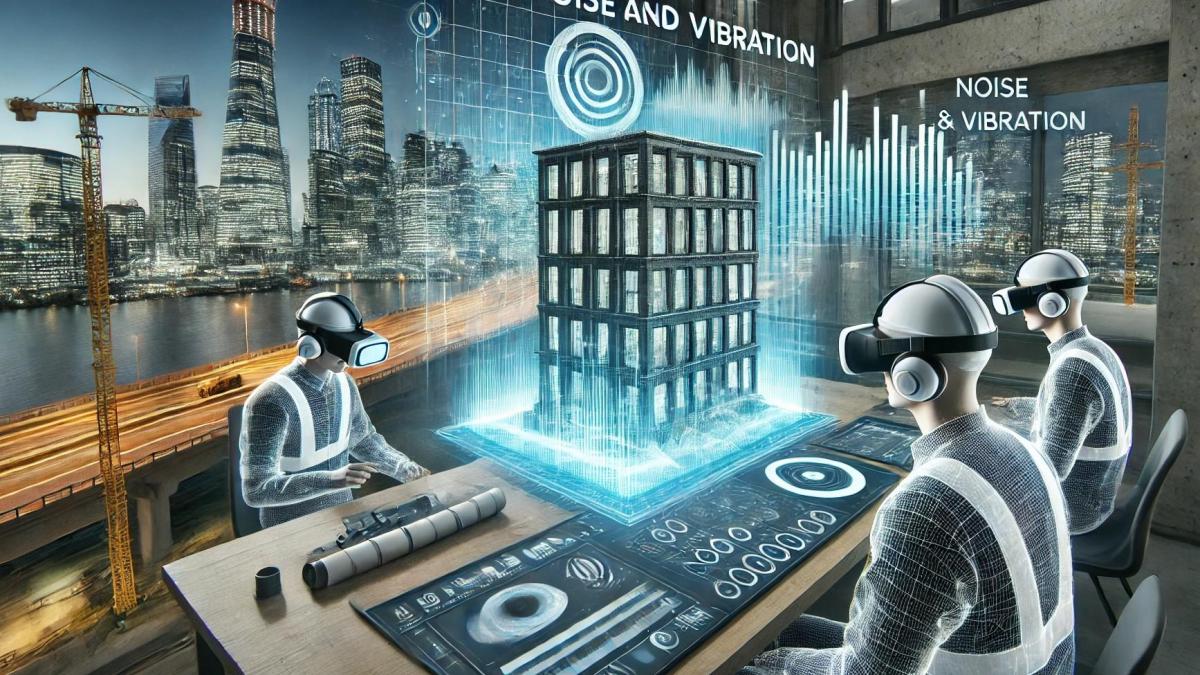R.E.News future Technology-Redefining Noise and Vibration Management with BIM and VR Technologies
 23/12/24-FR-English-NL-footer
23/12/24-FR-English-NL-footer
Redéfinir la gestion du bruit et des vibrations avec les technologies BIM et VR
 Image- R.E.News
Image- R.E.News
À mesure que les villes deviennent de plus en plus denses et interconnectées, la demande de systèmes de transport souterrains comme les métros, les autoroutes et les chemins de fer à grande vitesse a augmenté. Dans les métropoles animées telles que Séoul, de vastes projets de développement souterrain, notamment l'enfouissement des voies ferrées et des autoroutes, sont activement poursuivis pour améliorer la mobilité urbaine et réduire la congestion en surface.
Cependant, ces progrès s’accompagnent de défis importants. Le dynamitage d'excavations profondes, pierre angulaire de la construction souterraine, suscite souvent des inquiétudes parmi les résidents locaux concernant le bruit, les vibrations et la stabilité du sol.
Les incidents de plaintes concernant le bruit, tels que les 170 cas enregistrés lors de la construction de l'autoroute urbaine de la boucle intérieure de Busan, soulignent l'urgence de résoudre efficacement ces problèmes. Les citoyens expriment souvent leur inconfort face aux perturbations causées par les activités d'excavation sous leurs communautés, où les impacts sont intangibles mais profondément ressentis.
Cette appréhension croissante du public souligne la nécessité de solutions de pointe pour minimiser l’impact environnemental, renforcer la sécurité et apaiser les inquiétudes des citoyens.
Entrez dans l'Institut coréen de génie civil et de technologie du bâtiment (KICT), qui a dévoilé une innovation révolutionnaire : le premier simulateur d'impact de bruit et de vibration basé sur le BIM (Building Information Modeling) et la VR (Réalité virtuelle) du pays. Cet outil sophistiqué vise à redéfinir la manière dont les projets de fouilles profondes sont gérés et communiqués au public.
En tirant parti de la technologie BIM, le simulateur de KICT visualise les impacts sonores et vibratoires du dynamitage avec des détails sans précédent. Il fournit des informations exploitables, telles que le rayon d'impact, permettant aux équipes de projet de planifier et d'exécuter les activités de dynamitage avec précision. Parallèlement, l’intégration de la technologie VR offre une approche plus immersive. Les parties prenantes, y compris les résidents, peuvent être directement confrontées au bruit et aux vibrations liés à la construction, favorisant ainsi une meilleure compréhension et atténuant l’anxiété.
Le système innovant de KICT combine une technologie avancée de vibration basée sur les ondes sonores avec une base de données complète d'impacts mesurés et simulés. Cette approche à deux niveaux garantit une précision inégalée, certifiée par la Telecommunications Technology Association (TTA), un organisme national de test des TIC. Les habitants et les acteurs du projet peuvent utiliser le simulateur pour :
Visualisez la portée et l’intensité du bruit et des vibrations.
Découvrez des scénarios spécifiques au site dans un environnement contrôlé.
Comprendre les méthodologies de construction et leurs mesures d’atténuation.
En offrant une expérience tangible de ce à quoi s'attendre, le simulateur transforme des préoccupations abstraites en réalités compréhensibles, renforçant ainsi la confiance entre les équipes de construction et le public.
L'une des caractéristiques les plus remarquables du simulateur est sa capacité à traiter de manière préventive les plaintes des citoyens. Dr. MyoungBae Seo, chercheur principal au KICT, souligne son importance : « La technologie développée est une solution pour traiter de manière préventive les plaintes qui peuvent survenir lors de la construction d'infrastructures de transport souterraines urbaines. On s'attend à ce qu'il joue un rôle central dans les projets en cours et futurs, garantissant la sécurité publique et la tranquillité d'esprit.
Cette approche proactive s’aligne sur les tendances mondiales du développement urbain. À l’échelle internationale, des efforts similaires sont déployés pour intégrer des outils avancés de gestion du bruit et des vibrations dans les projets de construction urbaine. Pourtant, le mélange de BIM et de réalité virtuelle proposé par KICT reste un pionnier dans la combinaison d'une technologie de pointe et d'applications pratiques.
Le développement de ce simulateur n’a pas été une mince affaire. Il impliquait une collaboration de 18 institutions, dont des universités de premier plan telles que Konkuk et Hanyang, aux côtés de géants de l'industrie comme GS Engineering & Construction et Hyundai Engineering & Construction. Le projet a été financé par le ministère coréen des Terres, des Infrastructures et des Transports, démontrant l'engagement du gouvernement à améliorer les infrastructures urbaines.
Dr. Changyong Kim, chef de l'équipe de recherche, souligne le potentiel du simulateur : « Nous continuerons à étendre l'applicabilité de ces résultats aux projets de développement d'infrastructures de transport souterraines, tels que les récentes initiatives d'autoroute souterraine et de mise en souterrain de voies ferrées. »
Pour poursuivre cette mission, KICT a déjà transféré deux brevets essentiels liés au simulateur à des entreprises privées, accélérant ainsi son chemin vers la commercialisation. Avec ces développements, le simulateur est en passe de devenir un outil indispensable dans les projets d'infrastructures urbaines, tant en Corée qu'à l'étranger.
Durabilité et innovation
Les efforts du KICT ne s'arrêtent pas là. L'institut continue d'explorer des moyens d'améliorer la sécurité des travaux de construction et de minimiser les perturbations environnementales. Le simulateur, qui met l'accent sur la transparence et la collaboration, témoigne de la manière dont la technologie peut combler le fossé entre le développement des infrastructures et la satisfaction du public.
De plus, ses applications s’étendent au-delà du dynamitage souterrain. En simulant divers scénarios de bruit et de vibrations, l'outil peut être adapté à un large éventail de projets de construction, ce qui en fait un ajout polyvalent à l'arsenal du secteur de la construction.
Une nouvelle référence pour le développement urbain
Le développement de simulateurs d’impact sonore et vibratoire basés sur le BIM et la VR marque un tournant décisif pour la construction urbaine. En combinant une planification précise et un engagement public immersif, KICT établit une nouvelle norme en matière de croissance durable et inclusive des villes.
À mesure que l’urbanisation mondiale s’accélère, de telles innovations joueront sans aucun doute un rôle crucial dans l’élaboration des villes de demain.
NJC.© Info Korea Institute of Civil Engineering and Building Technology (KICT)
------------------------------------------------------------------------------------------------------------------
 23/12/24-English
23/12/24-English
Redefining Noise and Vibration Management with BIM and VR Technologies
 Image- R.E.News
Image- R.E.News
As cities grow denser and more interconnected, the demand for underground transportation systems like subways, expressways, and high-speed railways has surged. In bustling metropolises such as Seoul, extensive underground development projects, including the undergrounding of railways and expressways, are being aggressively pursued to enhance urban mobility and reduce surface congestion.
However, with these advancements come significant challenges. Deep excavation blasting—a cornerstone of underground construction—often raises concerns among local residents about noise, vibrations, and ground stability.
Incidents of noise complaints, such as the 170 cases recorded during the Busan Inner Loop urban expressway construction, underscore the urgency of addressing these issues effectively. Citizens frequently express unease about disturbances from excavation activities beneath their communities, where the impacts are intangible but deeply felt.
This growing public apprehension underscores the need for cutting-edge solutions to minimise environmental impact, bolster safety, and alleviate citizen concerns.
Enter the Korea Institute of Civil Engineering and Building Technology (KICT), which has unveiled a ground-breaking innovation: the nation’s first BIM (Building Information Modelling) and VR (Virtual Reality) based noise and vibration impact simulator. This sophisticated tool aims to redefine the way deep excavation projects are managed and communicated to the public.
By leveraging BIM technology, KICT’s simulator visualises the noise and vibration impacts of blasting in unprecedented detail. It provides actionable insights, such as the radius of impact, enabling project teams to plan and execute blasting activities with precision. Meanwhile, the integration of VR technology offers a more immersive approach. Stakeholders, including residents, can experience construction-related noise and vibrations firsthand, fostering better understanding and easing anxieties.
KICT’s innovative system combines advanced sound wave-based vibration technology with a comprehensive database of measured and simulated impacts. This dual-layered approach ensures unparalleled accuracy, certified by the Telecommunications Technology Association (TTA), a national ICT testing body. Residents and project stakeholders can use the simulator to:
Visualise the range and intensity of noise and vibrations.
Experience site-specific scenarios in a controlled environment.
Understand construction methodologies and their mitigative measures.
By offering a tangible experience of what to expect, the simulator transforms abstract concerns into comprehensible realities, ultimately strengthening trust between construction teams and the public.
One of the simulator’s standout features is its capacity to preemptively address citizen complaints. Dr. MyoungBae Seo, a leading researcher at KICT, highlights its significance: “The developed technology is a solution to preemptively address complaints that may arise during the construction of urban underground transportation infrastructure. It’s expected to play a pivotal role in ongoing and future projects, ensuring public safety and peace of mind.”
This proactive approach aligns with global trends in urban development. Internationally, similar efforts are being made to integrate advanced noise and vibration management tools into urban construction projects. Yet, KICT’s blend of BIM and VR remains a trailblazer in combining cutting-edge technology with practical applications.
The development of this simulator was no small feat. It involved a collaboration of 18 institutions, including leading universities such as Konkuk and Hanyang, alongside industry giants like GS Engineering & Construction and Hyundai Engineering & Construction. The project was funded through Korea’s Ministry of Land, Infrastructure, and Transport, demonstrating the government’s commitment to enhancing urban infrastructure.
Dr. Changyong Kim, head of the research team, emphasises the simulator’s potential: “We will continue to expand the applicability of these outcomes to underground transportation infrastructure development projects, such as the recent underground expressway and railway undergrounding initiatives.”
To further this mission, KICT has already transferred two critical patents related to the simulator to private companies, accelerating its path to commercialisation. With these developments, the simulator is poised to become an indispensable tool in urban infrastructure projects, both in Korea and abroad.
Sustainability and Innovation
KICT’s efforts don’t stop here. The institute continues to explore ways to enhance construction safety and minimise environmental disruption. The simulator, with its emphasis on transparency and collaboration, is a testament to how technology can bridge the gap between infrastructure development and public satisfaction.
Moreover, its applications extend beyond underground blasting. By simulating various noise and vibration scenarios, the tool can be adapted for a wide range of construction projects, making it a versatile addition to the construction industry’s arsenal.
A New Benchmark for Urban Development
The development of BIM and VR-based noise and vibration impact simulators marks a watershed moment for urban construction. By combining precision planning with immersive public engagement, KICT is setting a new standard for how cities can grow sustainably and inclusively.
As global urbanisation accelerates, innovations like these will undoubtedly play a crucial role in shaping the cities of tomorrow.
NJC.© Info Korea Institute of Civil Engineering and Building Technology (KICT)
------------------------------------------------------------------------------------------------------------------
 23/12/24-NL
23/12/24-NL
Een nieuwe definitie van geluids- en trillingsbeheer met BIM- en VR-technologieën
 Image- R.E.News
Image- R.E.News
Naarmate steden dichter bij elkaar komen en meer met elkaar verbonden zijn, is de vraag naar ondergrondse transportsystemen zoals metro's, snelwegen en hogesnelheidslijnen enorm toegenomen. In bruisende metropolen als Seoel worden grootschalige ondergrondse ontwikkelingsprojecten, waaronder het ondergronds leggen van spoorwegen en snelwegen, op agressieve wijze nagestreefd om de stedelijke mobiliteit te vergroten en de congestie aan de oppervlakte te verminderen.
Deze ontwikkelingen brengen echter aanzienlijke uitdagingen met zich mee. Diepgraven van ontgravingen – een hoeksteen van ondergronds bouwen – roept bij omwonenden vaak zorgen op over lawaai, trillingen en grondstabiliteit.
Incidenten met klachten over geluidsoverlast, zoals de 170 gevallen die zijn geregistreerd tijdens de aanleg van de stedelijke snelweg in Busan Inner Loop, onderstrepen de urgentie van een effectieve aanpak van deze problemen. Burgers uiten vaak hun ongerustheid over verstoringen als gevolg van opgravingsactiviteiten onder hun gemeenschappen, waar de gevolgen ongrijpbaar maar diep voelbaar zijn.
Deze groeiende publieke bezorgdheid onderstreept de noodzaak van geavanceerde oplossingen om de impact op het milieu te minimaliseren, de veiligheid te vergroten en de zorgen van burgers weg te nemen.
Betreed het Korea Institute of Civil Engineering and Building Technology (KICT), dat een baanbrekende innovatie heeft onthuld: de eerste op BIM (Building Information Modelling) en VR (Virtual Reality) gebaseerde geluids- en trillingsimpactsimulator van het land. Deze geavanceerde tool heeft tot doel de manier te herdefiniëren waarop diepe opgravingsprojecten worden beheerd en aan het publiek worden gecommuniceerd.
Door gebruik te maken van BIM-technologie visualiseert de simulator van KICT de geluids- en trillingseffecten van explosies in ongekend detail. Het biedt bruikbare inzichten, zoals de impactradius, waardoor projectteams explosieactiviteiten met precisie kunnen plannen en uitvoeren. Ondertussen biedt de integratie van VR-technologie een meer meeslepende aanpak. Belanghebbenden, waaronder bewoners, kunnen bouwgerelateerde geluiden en trillingen uit de eerste hand ervaren, wat een beter begrip bevordert en de zorgen wegneemt.
Het innovatieve systeem van KICT combineert geavanceerde op geluidsgolven gebaseerde trillingstechnologie met een uitgebreide database van gemeten en gesimuleerde impacts. Deze tweelaagse aanpak zorgt voor een ongeëvenaarde nauwkeurigheid, gecertificeerd door de Telecommunications Technology Association (TTA), een nationale ICT-testinstantie. Bewoners en projectbetrokkenen kunnen de simulator gebruiken om:
Visualiseer het bereik en de intensiteit van geluid en trillingen.
Ervaar locatiespecifieke scenario's in een gecontroleerde omgeving.
Begrijp bouwmethoden en hun verzachtende maatregelen.
Door een tastbare ervaring te bieden van wat je kunt verwachten, transformeert de simulator abstracte zorgen in begrijpelijke realiteiten, waardoor uiteindelijk het vertrouwen tussen bouwteams en het publiek wordt versterkt.
Een van de opvallende kenmerken van de simulator is het vermogen om preventief klachten van burgers aan te pakken. Dr. MyoungBae Seo, een vooraanstaand onderzoeker bij KICT, benadrukt het belang ervan: “De ontwikkelde technologie is een oplossing om preventief klachten aan te pakken die kunnen ontstaan tijdens de aanleg van stedelijke ondergrondse transportinfrastructuur. Er wordt verwacht dat het een centrale rol zal spelen in lopende en toekomstige projecten, waardoor de openbare veiligheid en gemoedsrust worden gewaarborgd.”
Deze proactieve aanpak sluit aan bij mondiale trends in stedelijke ontwikkeling. Internationaal worden soortgelijke inspanningen geleverd om geavanceerde instrumenten voor geluids- en trillingsbeheer te integreren in stedelijke bouwprojecten. Toch blijft KICT’s mix van BIM en VR een pionier in het combineren van geavanceerde technologie met praktische toepassingen.
De ontwikkeling van deze simulator was geen sinecure. Het betrof een samenwerking van 18 instellingen, waaronder vooraanstaande universiteiten als Konkuk en Hanyang, naast industriële giganten als GS Engineering & Construction en Hyundai Engineering & Construction. Het project werd gefinancierd door het Koreaanse Ministerie van Land, Infrastructuur en Transport, wat de inzet van de regering aantoont om de stedelijke infrastructuur te verbeteren.
Dr. Changyong Kim, hoofd van het onderzoeksteam, benadrukt het potentieel van de simulator: “We zullen de toepasbaarheid van deze resultaten blijven uitbreiden naar ontwikkelingsprojecten voor ondergrondse transportinfrastructuur, zoals de recente initiatieven voor ondergrondse snelwegen en spoorwegen.”
Om deze missie te verwezenlijken heeft KICT al twee cruciale patenten met betrekking tot de simulator overgedragen aan particuliere bedrijven, waardoor de weg naar commercialisering is versneld. Met deze ontwikkelingen is de simulator klaar om een onmisbaar hulpmiddel te worden bij stedelijke infrastructuurprojecten, zowel in Korea als in het buitenland.
Duurzaamheid en Innovatie
De inspanningen van KICT houden hier niet op. Het instituut blijft zoeken naar manieren om de bouwveiligheid te vergroten en verstoring van het milieu te minimaliseren. De simulator, met zijn nadruk op transparantie en samenwerking, is een bewijs van hoe technologie de kloof tussen infrastructuurontwikkeling en publieke tevredenheid kan overbruggen.
Bovendien reiken de toepassingen ervan verder dan ondergronds stralen. Door verschillende geluids- en trillingsscenario’s te simuleren, kan de tool worden aangepast voor een breed scala aan bouwprojecten, waardoor het een veelzijdige toevoeging is aan het arsenaal van de bouwsector.
Een nieuwe maatstaf voor stedelijke ontwikkeling
De ontwikkeling van op BIM en VR gebaseerde geluids- en trillingsimpactsimulatoren markeert een keerpunt voor de stedelijke bouw. Door precisieplanning te combineren met meeslepende publieke betrokkenheid, zet KICT een nieuwe standaard voor de manier waarop steden duurzaam en inclusief kunnen groeien.
Naarmate de mondiale verstedelijking versnelt, zullen dit soort innovaties ongetwijfeld een cruciale rol spelen bij het vormgeven van de steden van morgen.
NJC.© Info Korea Institute of Civil Engineering and Building Technology (KICT)
--------------------------------------------------------------------------------------------------------------------
Date de dernière mise à jour : 20/12/2024
















